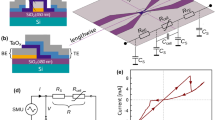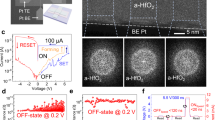Abstract
A detailed understanding of the resistive switching mechanisms that operate in redox-based resistive random-access memories (ReRAM) is key to controlling these memristive devices and formulating appropriate design rules. Based on distinct fundamental switching mechanisms, two types of ReRAM have emerged: electrochemical metallization memories, in which the mobile species is thought to be metal cations, and valence change memories, in which the mobile species is thought to be oxygen anions (or positively charged oxygen vacancies). Here we show, using scanning tunnelling microscopy and supported by potentiodynamic current–voltage measurements, that in three typical valence change memory materials (TaOx, HfOx and TiOx) the host metal cations are mobile in films of 2 nm thickness. The cations can form metallic filaments and participate in the resistive switching process, illustrating that there is a bridge between the electrochemical metallization mechanism and the valence change mechanism. Reset/Set operations are, we suggest, driven by oxidation (passivation) and reduction reactions. For the Ta/Ta2O5 system, a rutile-type TaO2 film is believed to mediate switching, and we show that devices can be switched from a valence change mode to an electrochemical metallization mode by introducing an intermediate layer of amorphous carbon.
This is a preview of subscription content, access via your institution
Access options
Subscribe to this journal
Receive 12 print issues and online access
$259.00 per year
only $21.58 per issue
Buy this article
- Purchase on Springer Link
- Instant access to full article PDF
Prices may be subject to local taxes which are calculated during checkout






Similar content being viewed by others
References
Baek, I. G. et al. Highly scalable non-volatile resistive memory using simple binary oxide driven by asymmetric unipolar voltage pulses. IEDM Tech. Dig. 587–590 (2004).
Waser, R. & Aono, M. Nanoionics-based resistive switching memories. Nature Mater. 6, 833–840 (2007).
Kaeriyama, S. et al. A nonvolatile programmable solid–electrolyte nanometer switch. IEEE J. Solid-State Circ. 40, 168–176 (2005).
Strukov, D. B. & Likharev, K. K. CMOL FPGA: a reconfigurable architecture for hybrid digital circuits with two-terminal nanodevices. Nanotechnology 16, 888–900 (2005).
Foelling, S., Tuerel, O. & Likharev, K. Single-electron latching switches as nanoscale synapses. Proc. IJCNN‘01, 216–221 (2001).
Pickett, M. D., Medeiros-Ribeiro, G. & Williams, R. S. A scalable neuristor built with Mott memristors. Nature Mater. 12, 114–117 (2013).
Jo, S. H. et al. Nanoscale memristor device as synapse in neuromorphic systems. Nano Lett. 10, 1297–1301 (2010).
Ohno, T. et al. Short-term plasticity and long-term potentiation mimicked in single inorganic synapses. Nature Mater. 10, 591–595 (2011).
Torrezan, A. C., Strachan, J. P., Medeiros-Ribeiro, G. & Williams, R. S. Sub-nanosecond switching of a tantalum oxide memristor. Nanotechnology 22, 485203 (2011).
Hasegawa, T., Terabe, K., Tsuruoka, T. & Aono, M. Atomic switch: atom/ion movement controlled devices for beyond von-Neumann computers. Adv. Mater. 24, 252–267 (2012).
Waser, R., Bruchhaus, R. & Menzel, S. in Nanoelectronics and Information Technology (ed. Waser, R.) 683–710 (Wiley, 2012).
Szot, K., Speier, W., Bihlmayer, G. & Waser, R. Switching the electrical resistance of individual dislocations in single-crystalline SrTiO3 . Nature Mater. 5, 312–320 (2006).
Yang, Y. et al. Electrochemical dynamics of nanoscale metallic inclusions in dielectrics. Nature Commun. 5, 4232 (2014).
Park, G.-S. et al. In situ observation of filamentary conducting channels in an asymmetric Ta2O5–x/TaO2–x bilayer structure. Nature Commun. 4, 2382 (2013).
Valov, I. et al. Atomically controlled electrochemical nucleation at superionic solid electrolyte surfaces. Nature Mater. 11, 530–535 (2012).
Nayak, A., Tsuruoka, T., Terabe, K., Hasegawa, T. & Aono, M. Switching kinetics of a Cu2S-based gap-type atomic switch. Nanotechnology 22, 235201 (2011).
Nayak, A. et al. Rate-limiting processes determining the switching time in a Ag2S atomic switch. J. Phys. Chem. Lett. 1, 604–608 (2010).
Chen, Y. L. et al. Scanning tunneling microscopy/spectroscopy studies of resistive switching in Nb-doped SrTiO3 . J. Appl. Phys. 112, 023703 (2012).
Yang, J. J., Strukov, D. B. & Stewart, D. R. Memristive devices for computing. Nature Nanotech. 8, 13–24 (2013).
Yang, J. J. et al. High switching endurance in TaOx memristive devices. Appl. Phys. Lett. 97, 232102 (2010).
Balatti, S., Larentis, S., Gilmer, D. C. & Ielmini, D. Multiple memory states in resistive switching devices through controlled size and orientation of the conductive filament. Adv. Mater. 25, 1474–1478 (2013).
Kroeger, F. A. The Chemistry of Imperfect Crystals (North-Holland, 1973).
Terabe, K., Hasegawa, T., Nakayama, T. & Aono, M. Quantized conductance atomic switch. Nature 433, 47–50 (2005).
Chien, T., Santos, T. S., Bode, M., Guisinger, N. P. & Freeland, J. W. Controllable local modification of fractured Nb-doped SrTiO3 surfaces. Appl. Phys. Lett. 95, 163107 (2009).
Valov, I. et al. Atomic scale and interface interactions in redox-based resistive switching memories. ECS Trans. 64, 3–18 (2014).
Davies, J. A., Domeij, B., Pringle, J. P. S. & Brown, F. The migration of metal and oxygen during anodic film formation. J. Electrochem. Soc. 112, 675–680 (1965).
Verkerk, B., Winkel, P. & de Groot, D. G. On the mechanism of anodic oxidation of tantalum. Phillips Res. Rep. 13, 506–508 (1958).
Whitton, J. L. The measurement of ionic mobilities in the anodic oxides of tantalum and zirconium by a precision sectioning technique. J. Electrochem. Soc. 115, 58–61 (1968).
Venkatu, D. A. & Poteat, L. E. Diffusion of titanium in single crystal rutile. Mater. Sci. Eng. 5, 258–262 (1970).
Khalil, N. & Leach, J. The anodic-oxidation of valve metals 1. Determination of ionic transport numbers by alpha-spectrometry. Electrochim. Acta 31, 1279–1285 (1986).
Habazaki, H. et al. Ionic transport in amorphous anodic titania stabilised by incorporation of silicon species. Corrosion Sci. 44, 1047–1055 (2002).
Akse, J. R. & Whitehurst, H. B. Diffusion of titanium in slightly reduced rutile. J. Phys. Chem. Solids 39, 457–465 (1978).
Hu, C. et al. Highly controllable and stable quantized conductance and resistive switching mechanism in single-crystal TiO2 resistive memory on silicon. Nano Lett. 14, 4360–4367 (2014).
Shibuya, K., Dittmann, R., Mi, S. & Waser, R. Impact of defect distribution on resistive switching characteristics of Sr2TiO4 thin films. Adv. Mater. 22, 411–414 (2010).
Linn, E., Rosezin, R., Kügeler, C. & Waser, R. Complementary resistive switches for passive nanocrossbar memories. Nature Mater. 9, 403–406 (2010).
Muenstermann, R., Menke, T., Dittmann, R. & Waser, R. Coexistence of filamentary and homogeneous resistive switching in Fe-doped SrTiO3 thin-film memristive devices. Adv. Mater. 22, 4819–4822 (2010).
Tsuruoka, T. et al. Effects of moisture on the switching characteristics of oxide-based, gapless-type atomic switches. Adv. Funct. Mater. 22, 70–77 (2012).
Tsuruoka, T., Terabe, K., Hasegawa, T. & Aono, M. Temperature effects on the switching kinetics of a Cu-Ta2O5-based atomic switch. Nanotechnology 22, 254013 (2011).
Tsuruoka, T., Terabe, K., Hasegawa, T. & Aono, M. Forming and switching mechanisms of a cation-migration-based oxide resistive memory. Nanotechnology 21, 425205 (2010).
Tappertzhofen, S., Waser, R. & Valov, I. Impact of counter electrode material on the redox processes in resistive switching memories. ChemElectroChem 1, 1287–1292 (2014).
Van den Hurk, J. et al. Physical origins and suppression of Ag dissolution in GeSx-based ECM cells. Phys. Chem. Chem. Phys. 16, 18217–18225 (2014).
Acknowledgements
This study was financially supported in part by BMBF project no. 03X0140 and DFG priority programme SFB 917. B.Y. and K.K.A. also acknowledge financial support from the MIT MRSEC through the MRSEC Program of the National Science Foundation under award no. DMR-1419807.
Author information
Authors and Affiliations
Contributions
I.V. conceived the idea and designed the study. A.W. and M.M. performed the STM experiments. M.L. conducted current–voltage measurements on TaOx devices. D.-Y.C. performed and interpreted the XAS measurements. K.S. prepared the samples for the STM experiments. V.R. performed I–V sweeps on TaOx, HfOx and TiOx devices. T.H., K.K.A. and B.Y. contributed to interpretation of the STM results. A.W. and I.V. wrote the manuscript. R.W. and I.V. directed the research. All authors contributed to the discussion of the results and improved the text.
Corresponding author
Ethics declarations
Competing interests
The authors declare no competing financial interests.
Supplementary information
Supplementary information
Supplementary information (PDF 1476 kb)
Rights and permissions
About this article
Cite this article
Wedig, A., Luebben, M., Cho, DY. et al. Nanoscale cation motion in TaOx, HfOx and TiOx memristive systems. Nature Nanotech 11, 67–74 (2016). https://doi.org/10.1038/nnano.2015.221
Received:
Accepted:
Published:
Issue Date:
DOI: https://doi.org/10.1038/nnano.2015.221
This article is cited by
-
Stochastic resonance in 2D materials based memristors
npj 2D Materials and Applications (2024)
-
Superior artificial synaptic properties applicable to neuromorphic computing system in HfOx-based resistive memory with high recognition rates
Discover Nano (2023)
-
Linear and symmetric synaptic weight update characteristics by controlling filament geometry in oxide/suboxide HfOx bilayer memristive device for neuromorphic computing
Scientific Reports (2023)
-
Open-loop analog programmable electrochemical memory array
Nature Communications (2023)
-
Biomemristor with Phototunable Resistive Switching Characteristics of a Neem (Azadirachta indica)-Carbon Quantum Dots Composite Thin Film
Journal of Electronic Materials (2023)



